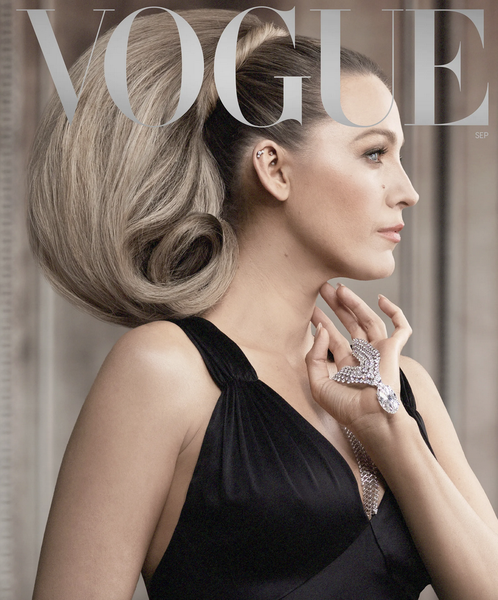
Every now and then, a major production comes along that is a staggering mix of so many genres, celebrities and brands vying for attention that you don’t know where to begin.
I
speak of the September issue of Vogue magazine, which this year is a startling intersection of many parts of the zeitgeist.
Of course, the edition itself is iconic, historically the
most critical and weighty Vogue issue of the year.
I mean weighty in the truest sense. It might sound unfathomable now. But back in 2012, in the waning days of print as king and queen,
Vogue’s September issue, featuring a provocative cover shot of Lady Gaga looking like a fashion-forward lion, weighed in at a door-stopping 4.5 pounds and 916 pages.
Adding to its
mystique, “The September Issue” was also the title of a popular and fascinating 2009 documentary directed by R.J.Cutler (“War Room”). He followed editor in chief Anna Wintour
(often described as “frosty”) for seven months, filming the behind-the-scenes drama of producing the 2007 edition, which ended up breaking then records at 4.1 pounds and 840 pages.
advertisement
advertisement
To put a good spin on it, this digital-age print version of September Vogue has slimmed down considerably, to a way-more-liftable 200-plus pages.
But it’s still getting a lot
of attention for featuring the actress Blake Lively silhouetted on the cover in profile, as a Cleopatra-meets-the-fall (that is, an old-fashioned hair fall) superstar.
There are no cover
lines, save for three words: “Blake by Baz.”
That’s because the cover and the amazingly lavish and cinematic photos for the profile inside were shot and
“directed” by Baz Luhrmann, who brings a heightened, quasi-operatic feel to all that he does.
But here’s where I’ll admit I got confused. There’s been much
publicity lately about Lively’s star turn in the buzzy thriller “Here’s Where It Ends,” based on the bestseller about a woman dealing with a violent and abusive husband. The
film was released last Friday, in the same week as the magazine.
I didn’t get why Lively was promoting a movie by Baz Luhrmann in Vogue at the same time, while the writer of the
piece describes meeting her in Rome, on the set of a thirdmovie.
I’m so gullible that it took me a while to get that Luhrmann’s big production numbers are part of a fake
film, in photographs, for Vogue. In a convincing homage to the 1955 Alfred Hitchcock French Riviera-based thriller “To Catch a Thief “ starring Cary Grant and Grace Kelly,
this time Lively plays Grant’s role of the cat burglar, plus others, with Hugh Jackman onboard as her tuxedoed love interest.
Now the plot thickens. The much-hyped-and-awaited
Marvel blockbuster, “Deadpool & Wolverine” successfully debuted at the end of July. The third in a series, it stars Lively’s husband, Ryan Reynolds, and his long-time cinematic
enemy and real-life friend, Jackman, the song-and-dance man in the yellow Wolverine costume.
Lively is often quoted saying that she and her husband share in rewriting and editing everything
they work on independently, and that Reynolds (also owner of ad agency Maximum Effort) rewrote some of the dialogue in “It Ends” -- which was news to the screenwriter, who later
graciously allowed for it.
Anyway, there’s a clear repetitive throughline to the Vogue profile: both Jackman and Luhrmann are quoted swooning over the
“transformation” that the former Gossip Girl can make from typical mom of four to breakout, megawatt movie star.
The writer, Andrew Sean Greer, brings a cranked-up, operatic
quality to his prose, similar to what Luhrmann does visually in his films (and the magazine photo shoots that are supposed to be films).
At one point, Greer writes that Lively is not like a
typical celeb with practiced answers.
“It is more like being in a fast-moving river, one that is changing every minute—from acting to film editing to
running businesses to being a mother—and the current is so strong and sure, why not just go along for the ride?”
Here’s Hugh Jackman enthusing on
the same theme. He’s quoted talking about hanging out in the Lively-Reynolds household, with “900 kids”: "It is just as normal as can be, and Blake will be baking and cooking and
saying, ‘Let’s make pizza,’ and then the next thing you turn around,” he says, describing her changing for an event, “and there she is, this incredible star.
It’s…it’s astonishing to me.”
Not mentioned, thankfully, are all of the actual products and businesses that the Lively/ Reynolds team are attached to.
She just released a bunch of hair products, part of a line called Blake Brown, and his business empire, including Mint Mobile, is huge.
Judging from some of the pushback on
social media, the couple is straddling the line of overexposure. "Honestly sooo tired of Blake Lively and Ryan Reynolds's constant shameless self-promotion. They are both c-list actors but parade
themselves as much more,” one user wrote on Instagram.
Others criticized Luhrmann's creative direction, writing that they "just aged 80 years looking at this cover" and
"nooo this had so much potential."
It’s all part of the give and take of the digital universe. And right now, by dint of this highly produced “transformation,” of overlapping
stars and genres, Lively, Luhrmann and Vogue’s September issue are stretching the possibilities of print.